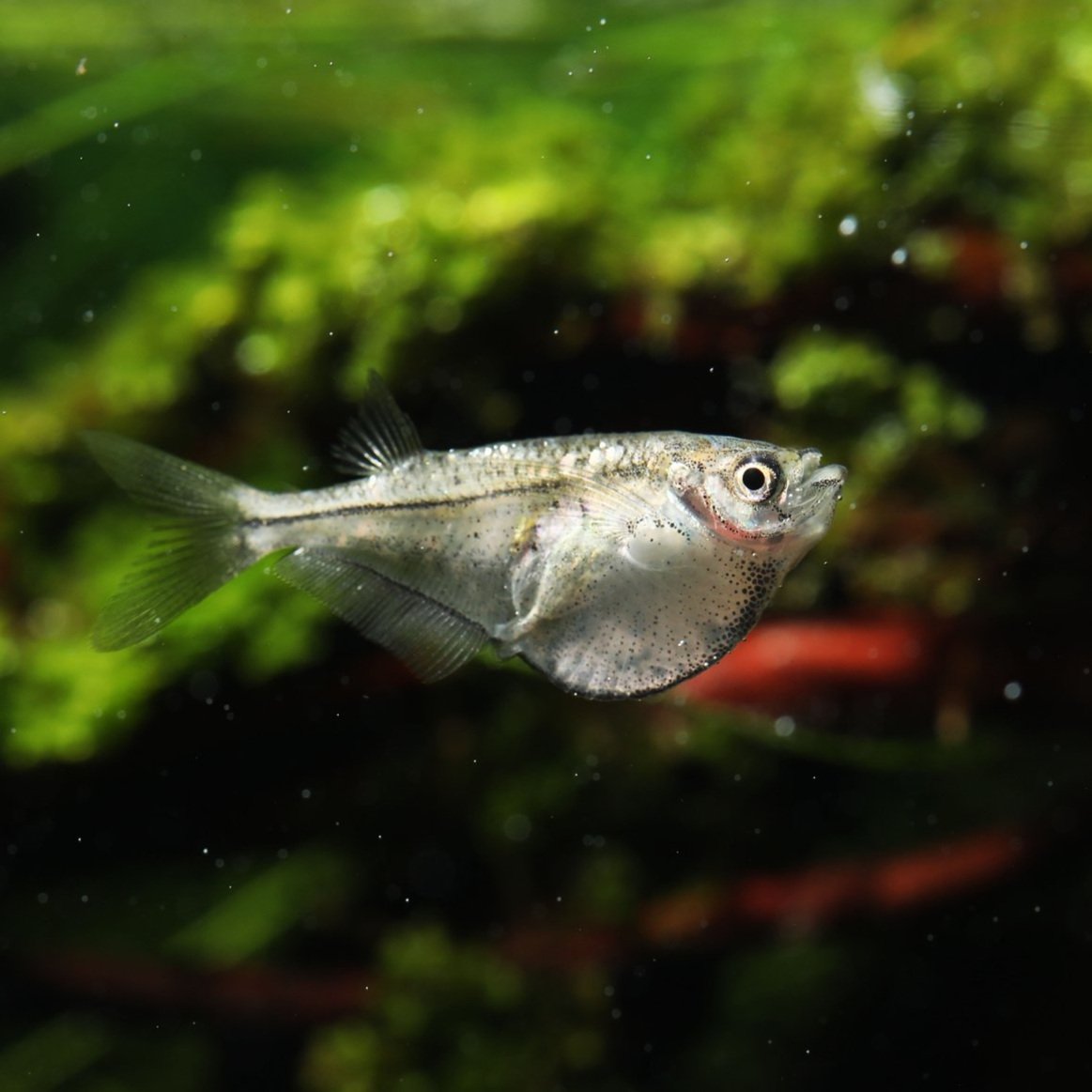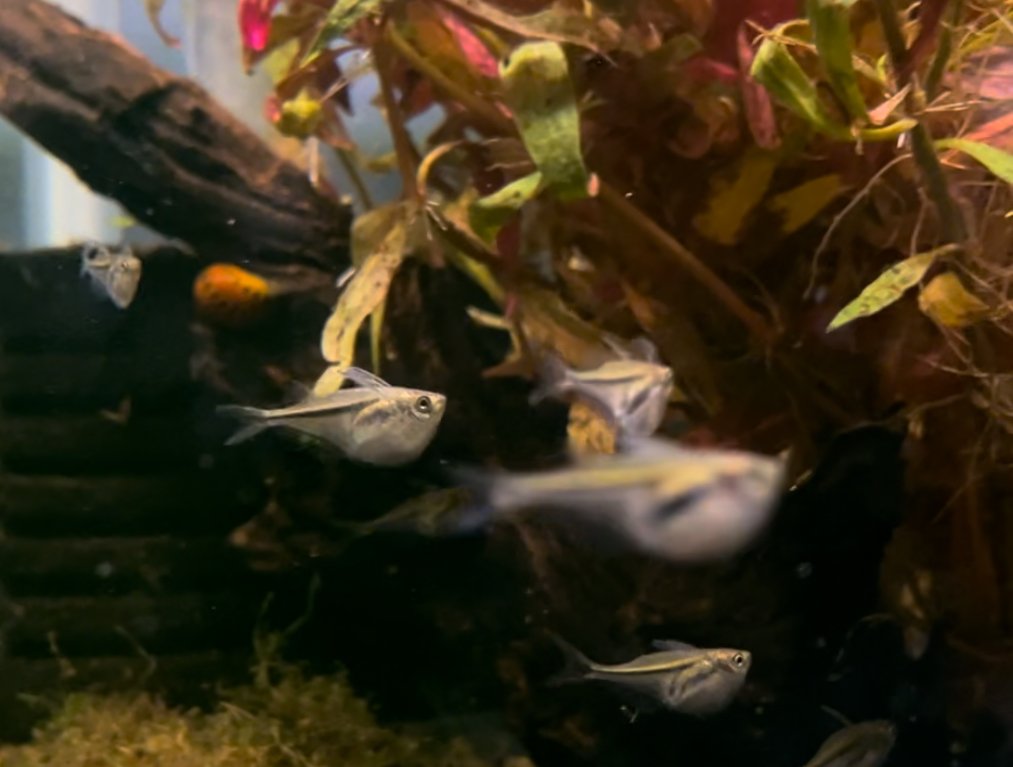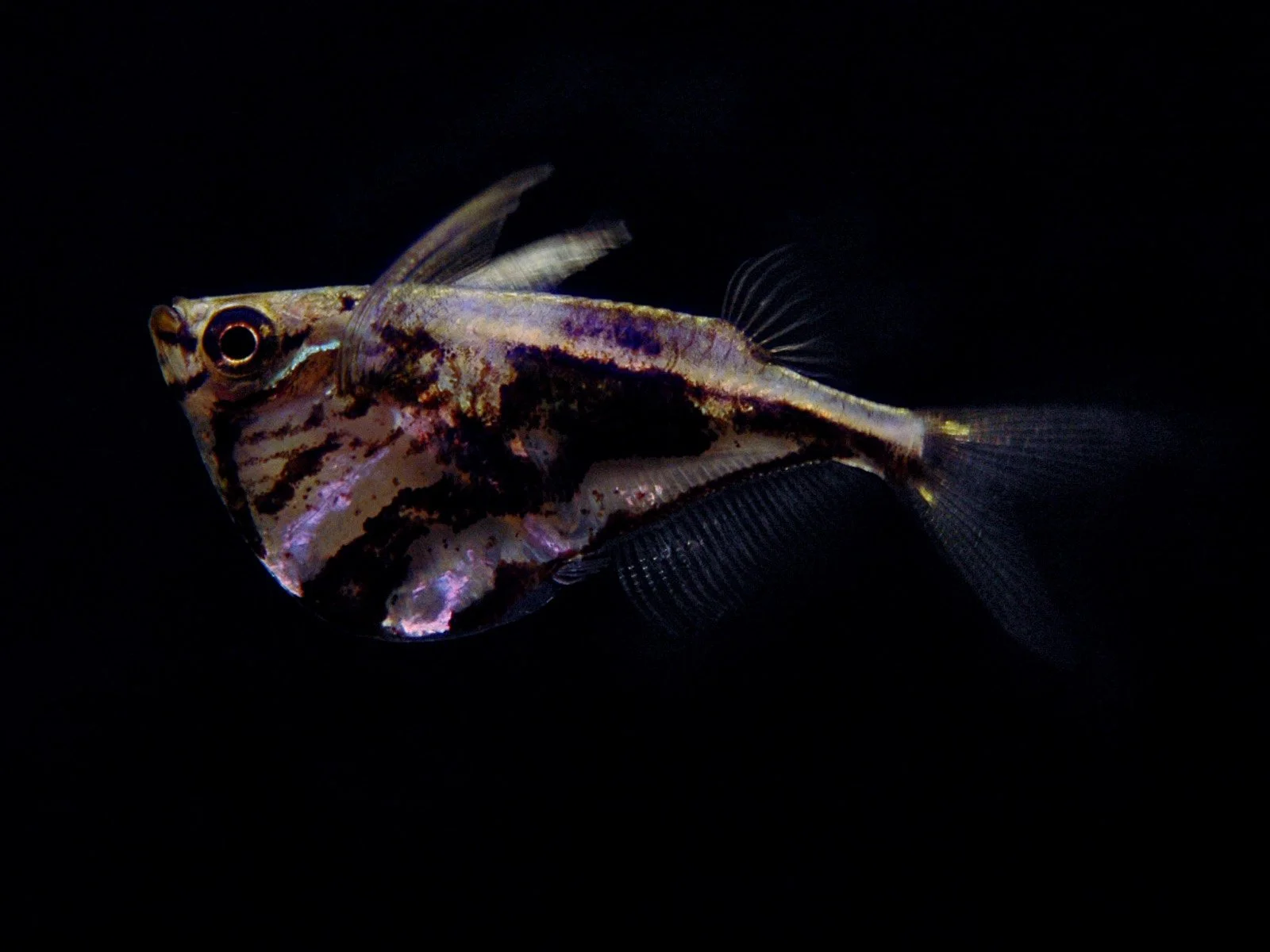 Image 1 of 2
Image 1 of 2

 Image 2 of 2
Image 2 of 2



Pygmy Hatchet- Group of 3
The Pygmy Hatchetfish, scientifically known as Carnegiella myersi, is a small, peaceful freshwater fish native to the upper Amazon River basin, particularly in Peru and surrounding regions. It inhabits slow-moving, shaded tributaries and blackwater streams where leaf litter and overhanging vegetation provide both cover and food sources. Its unique body shape and surface-dwelling behavior make it a fascinating and visually distinct species for the upper levels of a planted community aquarium.
Physically, Carnegiella myersi is one of the smallest hatchetfish species, typically reaching an adult length of just 0.8 to 1 inch (2 to 2.5 centimeters). It features a highly compressed, hatchet-shaped body with a silvery sheen, transparent fins, and a distinctive black stripe that runs along the midsection from the gill plate to the base of the tail. The pectoral fins are long and paddle-like, adapted for its gliding motion just beneath the water’s surface.
In the aquarium, the Pygmy Hatchetfish thrives in a well-maintained, peaceful environment with a tank size of at least 10 gallons. It is a shoaling species and should always be kept in groups of at least six to reduce stress and promote natural behavior. A heavily planted setup with floating plants, subdued lighting, and a secure lid is ideal—these fish are skilled jumpers and can easily escape from open tanks.
Water parameters should be soft and slightly acidic, with a temperature range of 74 to 82°F (23 to 28°C), a pH between 5.5 and 7.0, and low to moderate hardness. These fish are sensitive to poor water quality, so regular water changes and gentle filtration are essential.
Feeding Carnegiella myersi is simple, as they readily accept high-quality micro-pellets, flakes, and frozen or live foods such as daphnia, brine shrimp, and mosquito larvae. Due to their upturned mouths and surface-dwelling nature, all foods should be offered at the water’s surface.
Tankmates should be peaceful and similarly sized. Good companions include small tetras, rasboras, pencilfish, pygmy Corydoras, and dwarf shrimp. Avoid housing them with fast, aggressive, or larger species that may outcompete them for food or cause stress.
Breeding Carnegiella myersi in captivity is rare and challenging. As egg scatterers, they release their eggs near the water surface, often among floating plants. However, successful spawning typically requires soft, acidic water, a well-conditioned breeding group, and careful handling of the delicate fry.
Overall, Carnegiella myersi (Pygmy Hatchetfish) is a graceful, peaceful, and unusual species best suited to aquarists who appreciate subtle surface activity and a calm, natural-looking aquarium. Its small size, elegant gliding movements, and social nature make it a rewarding addition to well-planned planted tanks.
The Pygmy Hatchetfish, scientifically known as Carnegiella myersi, is a small, peaceful freshwater fish native to the upper Amazon River basin, particularly in Peru and surrounding regions. It inhabits slow-moving, shaded tributaries and blackwater streams where leaf litter and overhanging vegetation provide both cover and food sources. Its unique body shape and surface-dwelling behavior make it a fascinating and visually distinct species for the upper levels of a planted community aquarium.
Physically, Carnegiella myersi is one of the smallest hatchetfish species, typically reaching an adult length of just 0.8 to 1 inch (2 to 2.5 centimeters). It features a highly compressed, hatchet-shaped body with a silvery sheen, transparent fins, and a distinctive black stripe that runs along the midsection from the gill plate to the base of the tail. The pectoral fins are long and paddle-like, adapted for its gliding motion just beneath the water’s surface.
In the aquarium, the Pygmy Hatchetfish thrives in a well-maintained, peaceful environment with a tank size of at least 10 gallons. It is a shoaling species and should always be kept in groups of at least six to reduce stress and promote natural behavior. A heavily planted setup with floating plants, subdued lighting, and a secure lid is ideal—these fish are skilled jumpers and can easily escape from open tanks.
Water parameters should be soft and slightly acidic, with a temperature range of 74 to 82°F (23 to 28°C), a pH between 5.5 and 7.0, and low to moderate hardness. These fish are sensitive to poor water quality, so regular water changes and gentle filtration are essential.
Feeding Carnegiella myersi is simple, as they readily accept high-quality micro-pellets, flakes, and frozen or live foods such as daphnia, brine shrimp, and mosquito larvae. Due to their upturned mouths and surface-dwelling nature, all foods should be offered at the water’s surface.
Tankmates should be peaceful and similarly sized. Good companions include small tetras, rasboras, pencilfish, pygmy Corydoras, and dwarf shrimp. Avoid housing them with fast, aggressive, or larger species that may outcompete them for food or cause stress.
Breeding Carnegiella myersi in captivity is rare and challenging. As egg scatterers, they release their eggs near the water surface, often among floating plants. However, successful spawning typically requires soft, acidic water, a well-conditioned breeding group, and careful handling of the delicate fry.
Overall, Carnegiella myersi (Pygmy Hatchetfish) is a graceful, peaceful, and unusual species best suited to aquarists who appreciate subtle surface activity and a calm, natural-looking aquarium. Its small size, elegant gliding movements, and social nature make it a rewarding addition to well-planned planted tanks.
The Pygmy Hatchetfish, scientifically known as Carnegiella myersi, is a small, peaceful freshwater fish native to the upper Amazon River basin, particularly in Peru and surrounding regions. It inhabits slow-moving, shaded tributaries and blackwater streams where leaf litter and overhanging vegetation provide both cover and food sources. Its unique body shape and surface-dwelling behavior make it a fascinating and visually distinct species for the upper levels of a planted community aquarium.
Physically, Carnegiella myersi is one of the smallest hatchetfish species, typically reaching an adult length of just 0.8 to 1 inch (2 to 2.5 centimeters). It features a highly compressed, hatchet-shaped body with a silvery sheen, transparent fins, and a distinctive black stripe that runs along the midsection from the gill plate to the base of the tail. The pectoral fins are long and paddle-like, adapted for its gliding motion just beneath the water’s surface.
In the aquarium, the Pygmy Hatchetfish thrives in a well-maintained, peaceful environment with a tank size of at least 10 gallons. It is a shoaling species and should always be kept in groups of at least six to reduce stress and promote natural behavior. A heavily planted setup with floating plants, subdued lighting, and a secure lid is ideal—these fish are skilled jumpers and can easily escape from open tanks.
Water parameters should be soft and slightly acidic, with a temperature range of 74 to 82°F (23 to 28°C), a pH between 5.5 and 7.0, and low to moderate hardness. These fish are sensitive to poor water quality, so regular water changes and gentle filtration are essential.
Feeding Carnegiella myersi is simple, as they readily accept high-quality micro-pellets, flakes, and frozen or live foods such as daphnia, brine shrimp, and mosquito larvae. Due to their upturned mouths and surface-dwelling nature, all foods should be offered at the water’s surface.
Tankmates should be peaceful and similarly sized. Good companions include small tetras, rasboras, pencilfish, pygmy Corydoras, and dwarf shrimp. Avoid housing them with fast, aggressive, or larger species that may outcompete them for food or cause stress.
Breeding Carnegiella myersi in captivity is rare and challenging. As egg scatterers, they release their eggs near the water surface, often among floating plants. However, successful spawning typically requires soft, acidic water, a well-conditioned breeding group, and careful handling of the delicate fry.
Overall, Carnegiella myersi (Pygmy Hatchetfish) is a graceful, peaceful, and unusual species best suited to aquarists who appreciate subtle surface activity and a calm, natural-looking aquarium. Its small size, elegant gliding movements, and social nature make it a rewarding addition to well-planned planted tanks.







